Nintendo’s little pink puff ball is back and ball-ier than ever. Kirby and the Rainbow Curse is Kirby’s first game since last year’s 3DS title Kirby: Triple Deluxe, but it’s not a typical adventure for the doughy hero. As you’ve undoubtedly heard by now, Rainbow Curse has Kirby rolling around on a painted path that you draw with the stylus – it is in effect more the spiritual successor to 2005’s Kirby: Canvas Curse than the many other standard Kirby games inbetween. Our Kirby and the Rainbow Curse review looks at this newest entry to the series and we ponder if putting it on the Wii U was really the right choice.
Story
Even for a Kirby game, the story of Rainbow Curse is mostly absent. When a big bad pair of hands sucks the color out of Kirby’s world, our brave hero follows an anthropomorphic paintbrush through a portal into the hand’s universe. And… that’s it. As far as a central story is concerned, that’s really all there is. Nothing to connect the different worlds you go to, the enemies you face, or anything you do. It’s all about shuffling you from place to place with as little friction as possible.
What little else there is to the story is told through an adorable (adorable is going to be a theme in this review, stick around) little scrap book put together by the talking paintbrush. At the end of each level you can collect a page out of her scrapbook and view it later in the gallery – it shows things like Kirby and Ms. Paintbrush at the beach, Kirby stuffing his face full of food, or other equally adorable little tidbits.
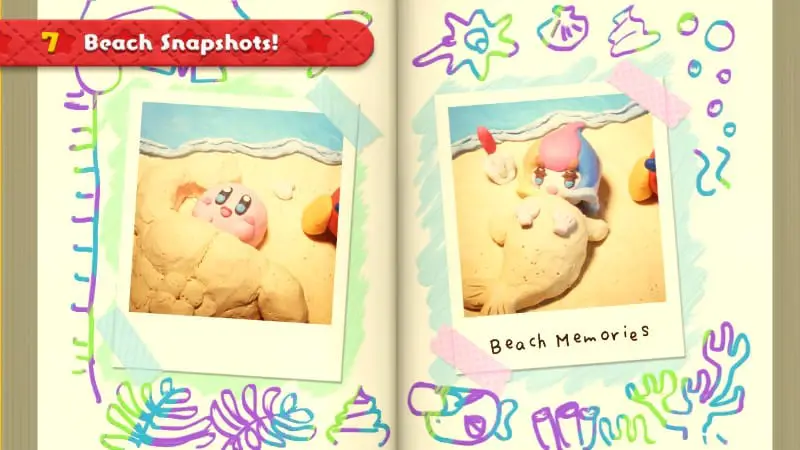
In the same vein there are also collectibles you can get throughout each level. When you view them in the gallery you can see small details about each character or object related to the collectible. As lacking as the story generally is, these collectibles almost make up for it. Every one of them is creatively written and got a laugh or two out of me. If you’ve played any entry in the Smash Bros. series and bothered to look through the trophies, you’ll know what you’re in for. It’s the same idea with the adorability factor turned up to 11.
Gameplay
Playing Kirby and the Rainbow Curse is as simple as understanding its story. Other than a few segments where Kirby transforms into different vehicles, the entirety of your movements in the game are done on the “rainbow ropes” that you draw with the Wii U GamePad’s stylus. Tapping on Kirby will cause him to roll faster, which is used to attack enemies and break walls, and if you get 100 stars you can tap and hold on Kirby for a super attack that launches him across the screen and can attack even better enemies and break even bigger walls. Various items are scattered around each level, such as stars, bigger stars, even bigger stars, food, paint canisters, and treasure chests. Almost all of them can be ignored if you want to just blow through the game, but the more stars you get the higher your score will be at the end of the level. Collecting the often difficult-to-get treasure chests will also net you a collectible – whether it be a trophy, music track, or other virtual knick knack.
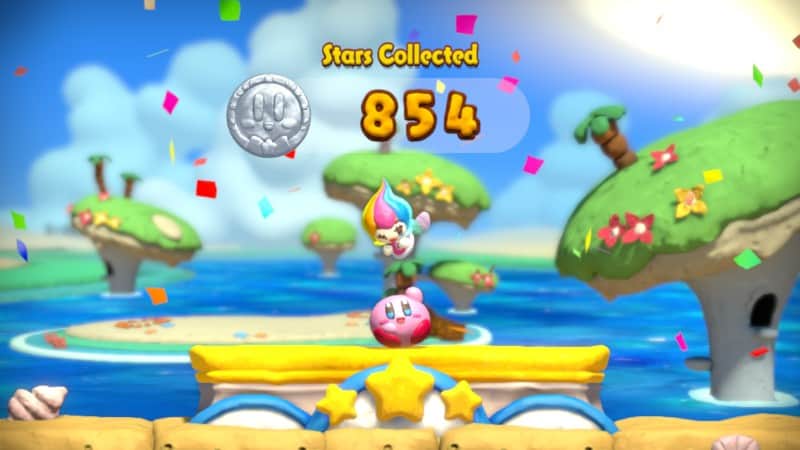
Those other vehicles I spoke of come at set points throughout the game. In all, you will end up transforming into a tank, a submarine, and a rocket before your time with Rainbow Curse is through. Each has their own play style that changes up how the game is played and they range from a fun change of pace to downright frustrating to control.
The best of the vehicles – or at the very least, my favorite – is definitely the tank, which continually moves along and will climb up any rope that you draw. If you click on a part of the screen it will shoot in that area, and it’s generally a lot of fun to play as, especially when the levels surrounding it get hectic and it’s a matter of shooting things in the right order in the right place.
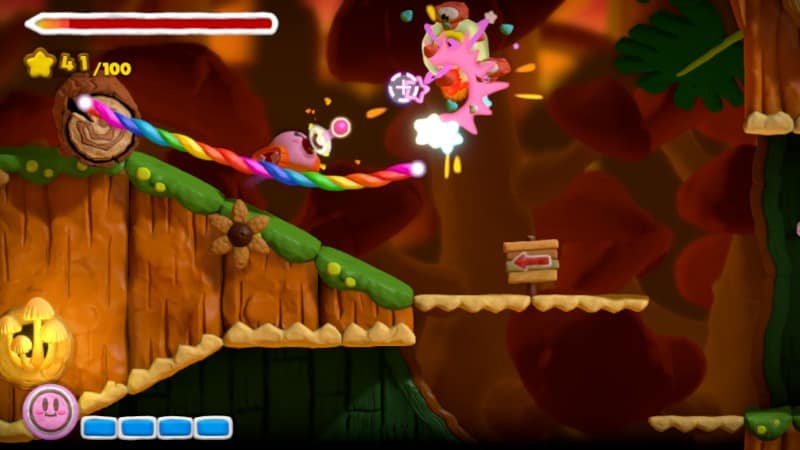
On the other end of the spectrum is the insanely annoying rocket transformation. This vehicle will continually move forward as well, but since it’s flying that means it will also run into the ground or hit at random directions, which you can direct by drawing ropes. It’s not a direction as much as a suggestion because, unlike the rest of the game, Kirby’s rocket form isn’t cooperative when it comes to sticking to the rope. You’ll often be trying to draw barriers and bouncing it around in the general direction you want it to go. It doesn’t help that these rocket sections also bring about annoyingly frustrating wide open “puzzles” where you have to plan your path out by drawing it on a map, then guiding your unruly rocket through the maze you draw. I can see what they were going for, but it just doesn’t work well.
Bosses are a bit of a letdown as well. There are only four unique bosses, and three of them are repeated with minor changes. The iconic tree that is in nearly every Kirby game makes an appearance, then comes back later coated in metal. A krakken (adorably named the “Claykken”) is an early boss, then comes back later coated in a layer of lava-protecting armor. There are minor changes with each boss and their upgraded counterpart, but seeing as there are so few bosses as it is, it’s a letdown that they’re even repeated at all.
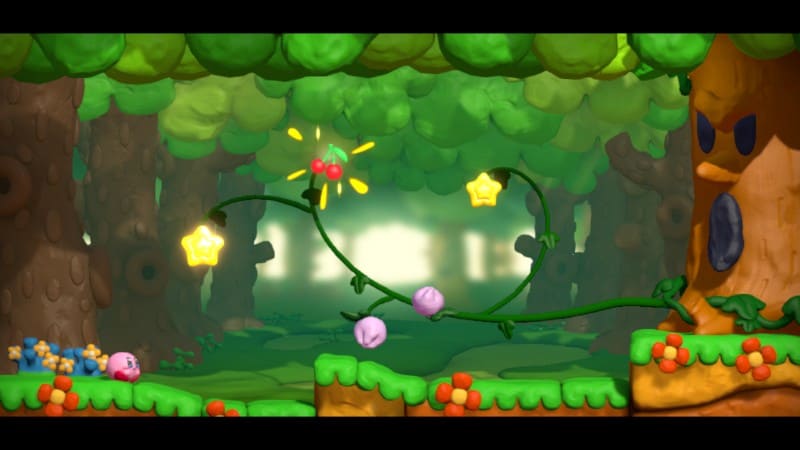
Throughout Rainbow Curse’s numerous worlds and levels, I never felt bored by the mechanics. Granted, the difficulty level never increases over a slight annoyance, so there’s never any tense moments. When the game does get difficult, it’s almost nothing more than just avoiding running into things. There admittedly isn’t very far they can stretch the idea of drawing a line and having a ball roll onto it, but Rainbow Curse does an admiral job trying to mix things up without getting too far away from its core. There are times you’ll be riding a gondola and using your rainbow ropes to connect physical ropes, and even one time at the end where Kirby will be split into two, requiring you to manage two separate games at once. It’s a relaxing little adventure with mostly simple puzzles that will occasionally require some quick reflexes.
The main problems with the game isn’t how it’s played – it’s where.
Hopefully you didn’t invest a lot of money into a TV to play Kirby and the Rainbow Curse, because you’ll never be looking at it. Given how much of your attention is required on the tiny, ugly, and unwieldy GamePad, you’ll never have a chance to see the gorgeous visuals on your actual TV. From a design perspective, it’s baffling why this game wasn’t put on the 3DS instead of the Wii U. Other than a multiplayer component (which is pretty fun), there is nothing that dictates Rainbow Curse being on Nintendo’s home console. Action on your TV screen is a constant mirror of what is on your GamePad, but there’s no way for you to look at it without losing your place on the hectic screen.
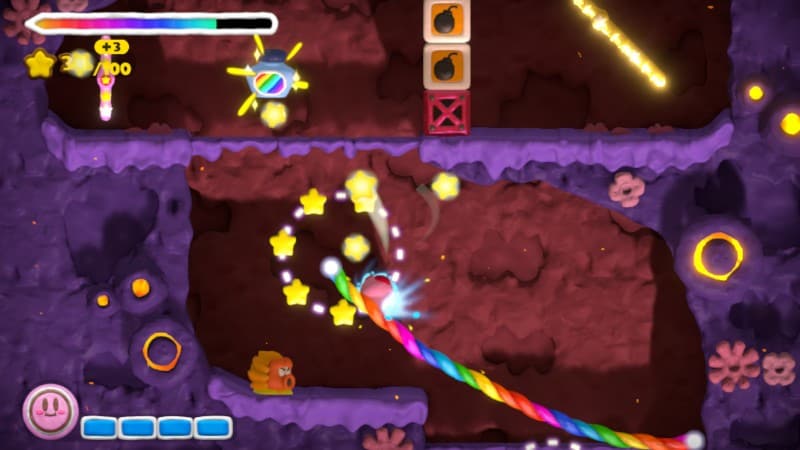
Being that a large majority of the game is played from left to right, right-handed gamers will also have the annoying experience of half the screen being blocked by your hand. Maybe this is Nintendo’s way of getting revenge for all those years that left-handed writers got ink and pencil dust on their hands while writing in their notebooks? Either way, it makes for a cumbersome gaming experience, and severely limits just how great the game could have been.
Graphics
Gorgeous, stunning, beautiful, and any other cliched video game adjective that can be used to describe Rainbow Curse should be used. The game is a visual feast of bright colors, wonderful claymation, and an unrelenting sense of cuteness. Nothing is an inanimate clay object either, as even the game’s menus bounce around while you sit idle on them. The game mostly stays true to its dedication to clay stop-motion animation. There are some parts where it needs to go with more normal animation for some of Kirby’s attacks, but it’s never too distracting.
Character designs are delightfully bizarre, and that bizarreness is only enhanced by the clay-inspired visuals. Even then weirdest of stone creatures wiggling their tongues at you still look adorable.
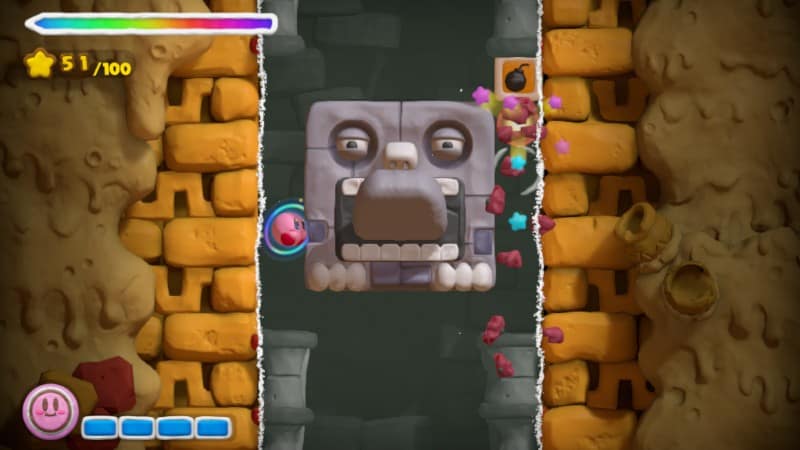
As great as the graphics are, they suffer the same issue as the gameplay – it’s all viewed on the low res GamePad screen. If you have friends around playing multiplayer or switching off between deaths, most of you will be treated to the visual bonanza, while the other will be hunched over a 6.2-inch screen constantly wondering how great this must look on the TV.
Sound
Nothing particularly sticks out in the sound design. The various tracks that you hear throughout the game, that can also be unlocked to listen to on their own, are good enough but not particularly memorable. As faithful as the visuals stay to the clay look and feel of the game, it’s a shame the sound design doesn’t do the same. Everything you hear is more or less the same effects you’ve heard in Kirby games for decades.
Multiplayer
Multiplayer wants to be the reason that Kirby and the Rainbow Curse is on the Wii U, but it’s not quite there. One player acting as the GamePad-wielding drawer of rainbow ropes and up to three other friends playing as different colored Waddle Dees can take to the screen at once. Waddle Dee can run on the ropes, but unlike Kirby, he can’t stick to them. So, as the GamePad player, you’ll also have to focus on creating walkable paths for your pals on top of moving your own character. Or you could always just let them fend for themselves, that’s always fun too.
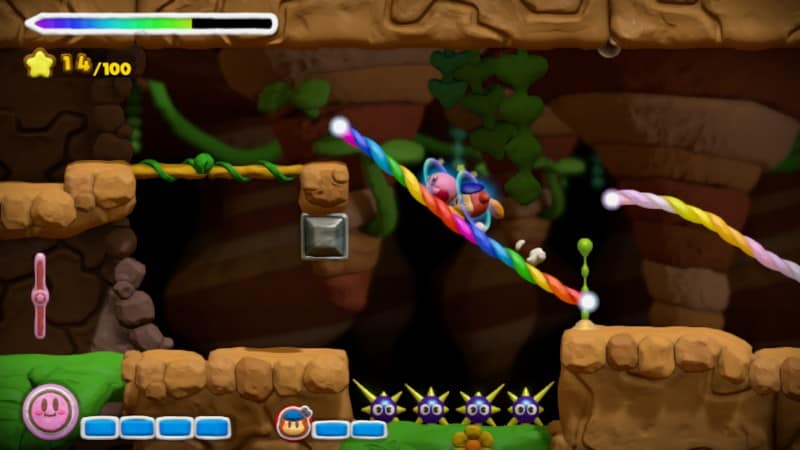
One unique aspect of multiplayer is the fact that mini bosses are introduced in every level. At a set part in each stage the screen will fade and all exits will lock while a floating hand enters the area. Kirby can do essentially nothing during the fight. Your job as the GamePad player is to avoid the hand by drawing crazy paths in hopes that you don’t get caught. If you do get caught by the hand, it’s up to the other 1-3 players to hit the hand until he drops his pink prisoner, otherwise he’ll carry Kirby off the screen and the gang loses a life. It’s a fun concept, even as the helpless Kirby player. No matter what role you’re playing it feeds into the strengths of that role, and it’s a test that comes about frequently. Kirby players need to be able to dodge and draw just the right lines to avoid the hand, and Waddle Dee players need to have their hitting and jumping game on point.
Multiplayer does get downright frustrating in later stages however, where the game is designed to be more difficult for Kirby and just plain inaccessible for players who aren’t tied to ropes. Often times the non-Kirby players will need to just float through parts of stages, which kills a lot of the fun of having so many people on screen.
Concept
Kirby and the Rainbow Curse has one simple concept in mind, and it doesn’t stray far from it. It’s a simple enough idea, and if it hadn’t already done this in its prequel, it might be held up as a great original game. As it is, there just isn’t anything all that original outside of great character design – it’s a short, simple platformer with simple puzzles.
Last Updated on November 27, 2018.










Comments are closed.